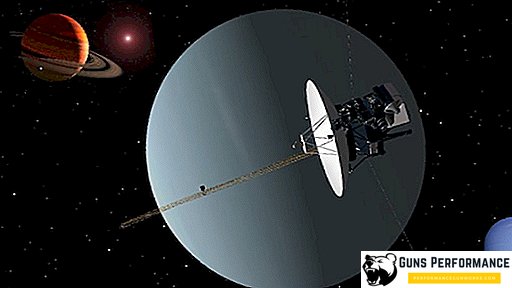Studies of the Solar System, conducted in the last quarter of the 20th century, gave science a number of surprising discoveries. With the help of new powerful optical telescopes of astrophysics, nuclear scientists, representatives of other branches of science and technology were able to obtain invaluable scientific data on the near space. Thanks to flights of space automatic probes, interesting facts about the composition and structure of the planetary system of our star became known to mankind. Finally, the scientific world has managed to get information about how the planet Uranus looks like, what Neptune represents and what the true dimensions of the Solar System are.

The most amazing planet of the solar system
Exploring near-Earth space through a telescope, it is easy to arrive at an erroneous opinion — the solar system is the simplest heliocentric mechanism in which all other space bodies and objects obey the known laws of physics and mathematics. In fact, everything is not as simple as it seems at first glance. Each celestial body in our nearest space lives its own life, has its own characteristics and is not much like its neighbors. A vivid example of this is the terrestrial planets, among which only the Earth and Mars can, with a stretch, be put in one row.

The situation is similar with another group of planets - gas giants - who make their run around the Sun in an outer circle. If Jupiter and Saturn have similar astrophysical parameters and characteristics, then Uranus on their background looks like the "black sheep". Despite the external similarity and the same structure, Uranus is the only planet of our star system, which occupies an unusual position. The specific feature of such a celestial body as Uranus is the following aspect. The planet does not just make a measured run in heliocentric orbit, but rolls like a billiard ball around the sun. Simply put, the planet simply lies on its side and rolls in the direction of its orbit. This behavior is not only not typical of the two other gas giants of the Solar System - Jupiter and Saturn, the position of the axis of rotation of Uranus with respect to the plane of its orbit looks unusual.
If we talk about how far the equator of Uranus is tilted to the plane of its orbit, then this value is 97.86⁰. For example, the Earth and Mars have an equator angle of inclination to the orbital plane of 23.45 and 25.19 degrees, respectively. The equator at Mercury and at Jupiter is almost perpendicular to the orbital plane. Uranus lies on its side and rotates retrograde. Such a position of the axis looks from a scientific point of view as nonsense, since in the seventh planet from the Sun, the change of day and night is observed only in a narrow sector of the planetary disk. The sunrise and sunset of the distant Sun takes place on the horizon of Uranus almost as much as in the polar latitudes on Earth. Due to this position of the axis of rotation of the planet, there is a curious moment - the difference in the duration of the Uranian year at the poles and at the equator. The poles of the planet meet day and night once during 42 Earth years, but at the equator the year is lengthened exactly twice and is 84 Earth years.

The position of the axis of rotation of the planet and the nature of the magnetic field of the seventh planet. Unlike other celestial bodies of the Solar system, the magnetic field of Uranus rotates along with the planet itself, constantly changing magnetic poles. In other words, the magnetic field of the planet Uranus periodically opens and closes. If this happened on Earth, we would have been expected every day by a planetary catastrophe.
Discovery of the seventh planet
The story of the discovery of the third gas giant is entirely connected with the name of the Englishman William Herschel. In 1781, the Englishman discovered a new celestial body, which was originally mistaken for a comet that visited the solar system. However, after some time, after studying the characteristics of the object in orbit around the sun, astronomer William Herschel decided to classify it as the seventh planet. This event has become a landmark in astronomy. For the first time in an instrumental way, a person managed to find a planet, the existence of which was previously unknown. Up to this point, astronomers relied on information about the existence of six planets, taking Uranus as a star. The idea of the size of the solar system was limited to the orbit of Saturn.

The Englishman, as a discoverer, proposed to name the seventh planet in honor of the English monarch - "George's star". This name did not suit the taste of the members of the Royal Astronomical Observatory, who decided to give the new planet the name Uranus, in honor of the ancient Greek divine symbol of the celestial sphere. Subsequently, when Herschel observed the movement of Uranus, a peculiarity of the behavior of this celestial body in orbit was noted. The seventh planet was moving unevenly in orbit, now accelerating, then slowing down its movement. Already after Herschel’s death, other astronomers, the Englishman Adams and Frenchman Laverye made the assumption that there is another large celestial body behind Uranus, whose gravity affects the behavior of the third gas giant. Subsequent mathematical calculations confirmed the correctness of the assumption, which made it possible in 1846 to open the last, eighth planet of the solar system, Neptune.
Thus, the discovery of Uranus entailed a chain reaction in the scientific world, which resulted in the expansion of the boundaries of the planetary system. Following Uranus, we got Neptune and Pluto - objects discovered by mathematical calculations.
Astrophysical characteristics: a brief description of the planet Uranus
Despite the external similarity with the first two gas giants of the Solar System, the seventh planet is significantly different from Jupiter and Saturn. Unlike Jupiter and Saturn, which can be quite well viewed with a telescope, Uranus in the lens looks like a small asterisk. This is due to the enormous distance that separates this distant world from our planet.

On the horizon of the Earth, the third giant is barely noticeable, representing a dim star, the brightness of which varies in the range of 5.9 - 5.32 magnitudes. Observing in a telescope behind a distant star of pale blue color, astronomers have long wondered what color the seventh planet really is. Scientists received the answer to this question only in 1986, when the Voyager-2 space probe flew 80 thousand kilometers. from the surface of a distant planet. The resulting images showed a pale blue, with a barely metallic tint, a planetary disk.
Distance from the Sun is on average 2 876 679 082 km. Uranus makes a run around the center of the star system in an almost elliptical orbit with a slight eccentricity (e), which is 0.46. The orbital period of the celestial body around the central star is 30,685 Earth days or 84 years. The speed of movement of this planet is low - only 6.8 kilometers per second. Only Neptune moves in space with an even lower orbital speed - 5.4 km / s.
If we talk about how much time it takes to travel from Earth to the third giant planet, here you can rely on the flight data of the same automatic Voyager 2 machine that flew to Uranus for almost 9 years. This is so far the only mission that allowed the earthlings to get ideas about this distant object and its surroundings.

Despite its modest size in the night sky, in reality the size of Uranus is impressive. The diameter of the planetary disk of this giant is 50,724 km. This is of course not so much as in Jupiter and Saturn, whose diameters are 140 thousand km and 116 thousand km, respectively. However, this is quite enough for the seventh planet of the solar system to firmly hold the third position.
Impressive observer and the mass of this celestial body. Uranium is 14.5 times heavier than Earth and weighs 8.6832 · 1025 kg. By its mass, the pale blue giant loses not only to Jupiter and Saturn. Even the distant satellite of Uranus, the planet Neptune, has a large mass. The relative lightness of a distant celestial body is due to its composition. Unlike the other two planets Jupiter and Saturn, where the bulk is represented by semi-liquid and metallized hydrogen and helium, Uranus represents a huge ice ball, which has a rotation speed around its own axis of 2.29 m / s.
The composition of the seventh planet and its atmosphere
Ice on Uranus is a variety of high-temperature modifications. There is frozen ammonia, water ice and methane in a solid, icy state. Due to the icy nature, the seventh planet was transferred by astrophysicists to the category of ice giants. The density of the ice ball is insignificant, almost three times less than the density of planet Earth and is 1.27 g / cm3. However, due to its large mass and orbital parameters, gravitational forces are quite strong on Uranus. The acceleration of free fall in the ice giant is almost identical to that of the earth and amounts to 8.87 m / s2.

Curious structure of a distant planet, which looks like this:
- solid stone core;
- ice mantle;
- imaginary surface;
- lower atmosphere (stratosphere and troposphere);
- planetary crown.
The surface of a celestial body is represented by compounds of hydrogen and helium, which are in a gaseous state. The atmosphere of the planet includes methane, thanks to which Uranus has a characteristic pale blue tint. Its concentration decreases with altitude, where, due to extremely low temperatures, methane freezes out, leaving room for hydrogen and helium. The exact chemical composition of the atmosphere of the seventh planet is not fully known, but judging from the spectrum, the atmosphere is mainly hydrogen, it also contains hydrocarbon compounds, which are the result of solar radiation on methane molecules. The layers of the atmosphere of the ice giant differ in thickness and temperature. The topmost layer is the atmospheric corona, which extends far beyond the planet to a distance of 8,000 km. The lower layers are the stratosphere and the troposphere, where low temperatures prevail. At an altitude of 50-300 km. from the surface is a layer of clouds consisting of water vapor, ammonia crystals and methane. Temperatures in this place reach 227-250 degrees Celsius with a minus mark.

Conclusion
Information that scientists have today about the third giant planet is extremely limited. This is due to the location of Uranus. Astrophysicists and scientists focused on the study of Jupiter and Saturn and the extreme regions of the solar system. Uranus, located in the middle of this community of celestial bodies, all the time was out of sight of research programs. The spacecraft "Voyager 2" has so far become the only ship that has reached the vicinity of a distant planet, providing the first documentary information about the planet Uranus, about the composition of its atmosphere and environment.

Like all other gas giants, which have their own system of celestial bodies, the scientists discovered a uranium ornament - a system of rings. Discovered and satellites of the planet Uranus, which today there are 27 pieces. With the help of the Hubble telescope in 2005, we managed to examine in detail the five largest satellites of Uranus - these are Miranda, Ariel, Umbriel, Titania and Oberon. A subsequent study of a distant planet and its satellites will probably provide new and useful information to scientists, but in the near future, missions to this part of the Solar System are not planned.












